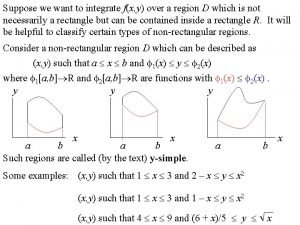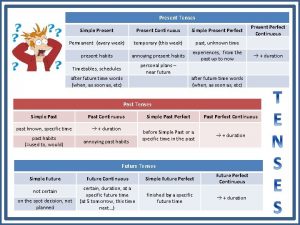Inner Classes Simple Uses of Inner Classes n





















- Slides: 21

Inner Classes

Simple Uses of Inner Classes n Inner classes are classes defined within other classes q q q The class that includes the inner class is called the outer class There is no particular location where the definition of the inner class (or classes) must be place within the outer class Placing it first or last, however, will guarantee that it is easy to find 2

Simple Uses of Inner Classes n An inner class definition is a member of the outer class in the same way that the instance variables and methods of the outer class are members q q q An inner class is local to the outer class definition The name of an inner class may be reused for something else outside the outer class definition If the inner class is private, then the inner class cannot be accessed by name outside the definition of the outer class 3

Inner/Outer Classes public class Outer { private class Inner { // inner class instance variables // inner class methods } // end of inner class definition // outer class instance variables // outer class methods } Aug 7, 2007 4

Simple Uses of Inner Classes n There are two main advantages to inner classes q q They can make the outer class more self-contained since they are defined inside a class Both of their methods have access to each other's private methods and instance variables 5

Have Access to Each Other's Private Members n Within the definition of a method of an inner class: q It is legal to reference a private instance variable of the outer class q It is legal to invoke a private method of the outer class q Essentially, the inner class has a hidden reference to the outer class n Within the definition of a method of the outer class q It is legal to reference a private instance variable of the inner class on an object of the inner class q It is legal to invoke a (nonstatic) method of the inner class as long as an object of the inner class is used as a calling object n Within the definition of the inner or outer classes, the modifiers public and private are equivalent 6

Class with an Inner Class public class Bank. Account{ private class Money{ private double amount; public Money(double amt){ amount = amt; } public double get. Amount() { return amount; } public void add. In (Money second. Amount) { amount = amount + second. Amount. get. Amount(); } } } 7

Class with an Inner Class 8

Referring to a Method of the Outer Class n If a method is invoked in an inner class q q q If the inner class has no such method, then it is assumed to be an invocation of the method of that name in the outer class If both the inner and outer class have a method with the same name, then it is assumed to be an invocation of the method in the inner class If both the inner and outer class have a method with the same name, and the intent is to invoke the method in the outer class, then the following invocation must be used: Outer. Class. Name. this. method. Name() 9

Public Inner Classes n If an inner class is marked public, then it can be used outside of the outer class n In the case of a nonstatic inner class, it must be created using an object of the outer class q q Bank. Account account = new Bank. Account(); Bank. Account. Money amount = account. new Money(41. 99); Note that the prefix account. must come before new The new object amount can now invoke methods from the inner class, but only from the inner class 10

Public Inner Classes n In the case of a static inner class, the procedure is similar to, but simpler than, that for nonstatic inner classes Outer. Class. Inner. Class inner. Object = new Outer. Class. Inner. Class(); q Note that all of the following are acceptable inner. Object. nonstatic. Method(); inner. Object. static. Method(); Outer. Class. Inner. Class. static. Method(); 11

Public Money Inner Class If the Money inner class in the Bank. Account example was defined as public, we can create and use objects of type Money outside the Bank. Account class. // this is okay in main( ) Bank. Account account = new Bank. Account( ); Bank. Account. Money amt= account. new Money(41. 99); System. out. println( amt. get. Amount( ) ); // but NOT this – why not? ? System. out. println( amt. get. Balance( ) ); 12

Static Inner Classes n A normal inner class has a connection between its objects and the outer class object that created the inner class object q This allows an inner class definition to reference an instance variable, or invoke a method of the outer class n Static inner class has no connection to an object of the outer class, n within a static inner class method q q Instance variables of the outer class cannot be referenced Nonstatic methods of the outer class cannot be invoked 13

Static Inner Classes n To invoke a static method or to name a static variable of a static inner class within the outer class, preface each with the name of the inner class and a dot n There are certain situations, when an inner class must be static q q If an object of the inner class is created within a static method of the outer class If the inner class must have static members 14

Multiple Inner Classes n A class can have as many inner classes as it needs. n Inner classes have access to each other’s private members as long as an object of the other inner class is used as the calling object. 15

The. class File for an Inner Class n Compiling any class in Java produces a. class file named Class. Name. class n Compiling a class with one (or more) inner classes causes both (or more) classes to be compiled, and produces two (or more). class files q Such as Class. Name. class and Class. Name$Inner. Class. Name. class 16

Nesting Inner Classes n It is legal to nest inner classes within inner classes q q The rules are the same as before, but the names get longer Given class A, which has public inner class B, which has public inner class C, then the following is valid: A a. Object = new A(); A. B b. Object = a. Object. new B(); A. B. C c. Object = b. Object. new C(); 17

Inner Classes and Inheritance n Given an Outer. Class that has an Inner. Class q q Any Derived. Class of Outer. Class will automatically have Inner. Class as an inner class In this case, the Derived. Class cannot override the Inner. Class n An outer class can be a derived class n An inner class can be a derived class also 18

Anonymous Classes n Is an un-named inner class n If an object is to be created, but there is no need to name the object's class, then an anonymous class definition can be used q q The class definition is embedded inside the expression with the new operator An anonymous class is an abbreviated notation for creating a simple local object within an expression, simply by wrapping the desired code in a "new" expression. 19

Anonymous Classes 20

Anonymous Classes 21
 By listening to my inner defender voice, i can be sure that
By listening to my inner defender voice, i can be sure that Inner critic and inner defender
Inner critic and inner defender Classes subclasses
Classes subclasses Pre ap classes vs regular classes
Pre ap classes vs regular classes Past simple future simple
Past simple future simple Past simple future simple
Past simple future simple Present simple present continuous past simple future simple
Present simple present continuous past simple future simple Past simple present simple future simple
Past simple present simple future simple Simple present, simple past, simple future
Simple present, simple past, simple future Past simple vs past continuous exercises
Past simple vs past continuous exercises Present and past tense
Present and past tense Frases afirmativas simple present
Frases afirmativas simple present Future simple present simple
Future simple present simple Give at least 5 tools in making simple electrical gadgets
Give at least 5 tools in making simple electrical gadgets Present simple and continuous uses
Present simple and continuous uses Present perfect i
Present perfect i Slide is an example of simple machine
Slide is an example of simple machine Uses of simple machine
Uses of simple machine X simple and y simple
X simple and y simple What is the simple predicate?
What is the simple predicate? Past simple and past continuous
Past simple and past continuous As if
As if






































